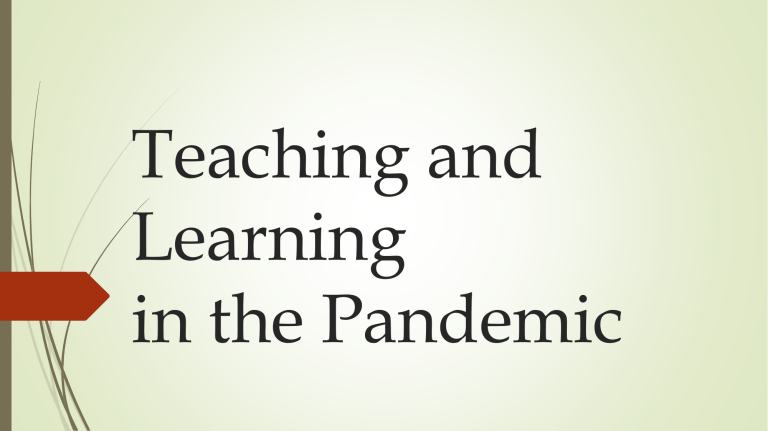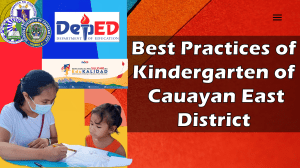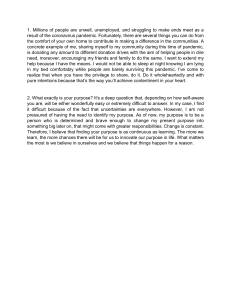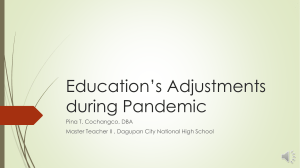
Teaching and Learning in the Pandemic The Covid-19 pandemic took the world by surprise. In this crisis we have lost important assets in teaching and learning process which is face-to-face and hands on learning. Parents and students reported the home learning program was more stressful than regular classroom. It was because parents were not used with this kind of arrangement dealing with their own children as their own pupils. Parents are teachers in Modular Distance Learning amidst Covid-19. And on the part of learner learning have been difficult but having friends make them more knowledgeable and less stressful. Teachers today teach in an empty classroom, the classroom as they’ve known was gone, and their instruction was more critical than ever. The pandemic produced crisis schooling, and teachers and schools scrambled to find online resources and master remote teaching techniques. We, as teachers have been stressed, we’re worried and we’re not trained on what we need to do. We tried our absolute best and we’re working harder than ever even some people say “teachers aren’t working”. “Teaching virtually/Distance teaching was a lot more work than actual teaching in class”. That was the thing some people do not know and that they feel like teachers just don’t want to go to work. Schools should acknowledge upfront that they’ll likely have less instructional time this year and should plan to identify the highest priority parts of their curriculum accordingly. Teachers will need to create flexible, adaptable activities that students can complete in different environments and with varied levels of technology access. Experts say “No students should be held back from gradelevel work—instead”, teachers and instructional leaders should figure out where they might need to revisit prerequisite skills in the context of instruction. That’s where a rethought approach to assessment can play a role. Experts are advising educators to focus more heavily on informal assessments and well-designed activities that “assess”, most critical things their students haven’t yet mastered. Teachers can then remediate those gaps “just in time,” instead of trying to cover every standard or skill that might have been missed. Professional development will carry an outsized burden this fall, too, as school staff members require training to serve not only as instructors, but as social-emotional supports for students. Connection and trust are as central to instruction as curricular mapping and assessment. More than ever before, it’s essential that instruction encourages strong, caring relationships with adults and provides opportunities for students to think deeply, to connect with their peers, and to get excited about learning again. Now more than ever, schools need to give all students access to grade-level work, experts say. Even if students had little instruction in the spring, districts should fight the impulse to require extensive remediation or reteaching. Tips for Teachers Working from home, or worse, from quarantine, is isolating and often depressing for both teachers and students. COMMUNICATE TO COLLEAGUES/SUPERIOR Make a concerted effort to speak to other colleagues and trusted professionals to provide emotional and psychological context to your work. Teaching at this moment is extraordinarily hard, and you’ll need the virtual company of people who are experiencing what you are. MIND THE GAP Your work will be hard, but there are students facing more severe challenges. Students with no internet or no computer will need support, as well those with learning differences or other circumstances that make distance learning especially difficult. Supporting these students was on almost everyone’s mind so don’t forget to “reach out to students as often as you can,” or you can facilitate peer-topeer communication so that kids with no internet can feel like they belong. Different Learning Delivery Modalities used in Teaching this Pandemic Distance Learning – refers to a learning delivery modality where a learner is given materials or access to resources and he/she undertakes self-directed study at home or in another venue Four Types of Distance Learning: 1. Modular Distance Learning refers to a learning delivery that is the form of individualized instruction where learners use selflearning modules in print or digital format, whichever is applicable in the context of the learner, with the guidance of any member of the family or other stakeholders. 2. Online Distance Learning refers to a learning delivery modality where the teacher facilitates ang engages learners’ active participation using various technologies connected to the internet while they are geographically remote from each other. 3. TV-based instruction/Radio-based instruction refers to the use of television or radio programs on channels or stations dedicated to providing learning content to learners as a form of distance education. 4. Blended Distance Learning: Any combination of the above DL types. Thus: - MDL and ODL -MDL and TVBI/RBI -ODL and TVBI/RBI -ODL, TVBI/RBI and MDL Thank You for listening






